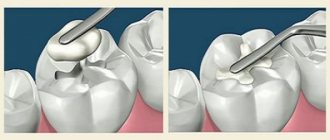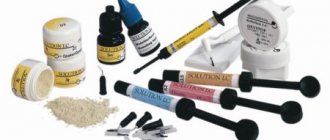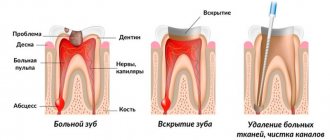When a tooth is destroyed, caries forms, or a filling is lost, the question of filling arises. Any defect in dentistry can be replaced using various types of fillings . Conservative therapeutic intervention allows you to stop the spread of caries and maintain an aesthetic appearance.
Dental clinics today use various types of materials : cement, plastic, ceramics, photopolymer components. One filling material is suitable for the front teeth, the other for the lateral and chewing elements of the dental system. In each case, the choice takes into account the clinical picture, the degree of pathology and possible contraindications.
Indications for placing a temporary filling
- Treatment of deep caries. After cleansing the tooth cavity from necrotic masses, the dentist places a medicinal solution that helps the dentin strengthen the layer between the pulp chamber and the open cavity.
- Diagnosis of the condition of the tooth with deep caries before installing a permanent filling.
- Acute pulpitis. A temporary intermediate composition is placed while the nerve is removed.
- Periodontitis. To relieve inflammation, an antiseptic or medicinal preparation is placed in the area of the tooth roots, which is then covered with light cement.
- Sanitation of dental canals before filling. The doctor cleans the canals, filling them with a disinfectant solution, then places a temporary filling.
- Prosthetics, restoration. The process of making an artificial crown or orthodontic structure takes several days. To protect against microbes, the open tooth cavity is closed with a temporary filling material.
Stages of placing a temporary filling:
- opening the tooth cavity, removing all affected dentin tissue;
- expansion, cleaning, treatment of dental canals;
- therapeutic stage (depending on the diagnosis, the nerve endings of the pulp are removed, medications are placed in the tooth cavity, and the canals are filled with temporary cement);
- The crown is closed with a temporary filling.
Filling using temporary materials
More often, such compositions are used after therapeutic and endodontic treatment. In most cases, they are preceded by x-ray diagnostics, which makes it possible to determine the type of damage and the extent of inflammation. Local anesthesia allows you to prepare, clean the carious cavity, remove the pulp and clean the canals without pain. To install a temporary filling, perform the following steps:
- treat the oral cavity with antiseptic agents;
- lay a medical pad - when required by the treatment protocol;
- filling material is placed on the tooth.
In acute periodontal disease, all actions are performed 2–3 times, so temporary compounds are used to fill the canals repeatedly. It's easy to remove them. To do this, the dentist will need a drill and hand tools.
Material of manufacture
Requirements for temporary filling materials:
- no toxic effect on tooth structures (enamel, dentin, pulp) and mucous membranes of the oral cavity;
- safety for human health;
- chemical inertness and high resistance to saliva and aggressive environments (alkalies, acids);
- mechanical strength, wear resistance, ductility;
- lack of galvanization effect;
- maintaining shape and size during hardening;
- good radiopacity.
The choice of material for a temporary filling depends on the clinical case, age, individual characteristics of the body (the presence of allergies to certain substances), as well as how long the patient will wear it.
Expert opinion
Lyubov Ivanovna Kopylova
dentist-therapist
Experience: more than 10 years
Temporary filling at home is an option for those who cannot get to the doctor for quality caries treatment. This is not an alternative method of dental treatment and is not an option for those who want to save money on visiting a doctor. Caries can be cured only in a dental clinic, using modern equipment for removing pathological tissue and high-quality filling material. It is important to understand that the temporary filling that you put on yourself does not stop the destructive process!
Intermediate filling materials
- A paste based on zinc sulfate and kaolin allows you to restore the crown of the tooth.
- Karyosan has an analgesic and antiseptic effect.
- Vinoxol is an artificial dentin. Withstands chewing load for up to 1-2 months.
- Cement with zinc and eugenol. It is used for antiseptic treatment of tooth tissue and relief of the inflammatory process.
- Glass ionomer cement is used for temporary fixation of the prosthesis.
- One-component polymer materials are pastes with a viscous consistency that harden under the light of a special lamp.
Preparing for installation
The process of preparing to install a temporary filling should be entrusted to a dentist. The main requirement: there should be no damaged or inflamed tissue in the cavity to be filled. If there is purulent content, the tooth is left open until the inflammatory process is completely eliminated.
All this time, the patient must carefully monitor the cleanliness of the oral cavity. It is recommended to rinse with antibacterial solutions prescribed by your doctor, and to avoid eating spicy foods that irritate the nerve endings.
How long does it take to wear a temporary filling?
Depending on the material of manufacture, a temporary filling has different characteristics of strength and tightness and can last from several days to six months.
Average duration of use of a temporary filling:
- 2-3 days, if a drug is placed under the filling that destroys the nerve endings of the pulp;
- 7–10 days while treatment of the inflammatory process with periodontitis or pulpitis continues;
- 2-3 weeks - for the period of manufacture of the orthopedic structure;
- several months in special diagnostic cases (when treating a dental cyst, restoring dentin after deep caries).
It is necessary to strictly adhere to the timing of wearing temporary fillings. If the time period is extended, its integrity and sealing may be compromised, which will negatively affect the health of the tooth. Thus, arsenic-based paste, if not removed after 2-3 days, begins to penetrate the dentin through the tubules, destroying bone tissue.
How long a temporary filling can be worn is decided by the attending physician, depending on the diagnosis and the chosen treatment method.
Removing a temporary filling is a mandatory procedure before placing a permanent filling. After removal of the temporary composite, antiseptic treatment of the root canals and dental cavity is carried out. Next, a permanent filling is installed.
Rules of care
Compliance with the hygienist’s recommendations for temporary filling is one of the main conditions for effective therapy. You should brush your teeth twice a day and rinse them after eating. It is worth using a soft toothbrush. The use of whitening or abrasive toothpastes is not recommended.
Before permanent filling or restoration, it is better to avoid nuts, crackers, toffees and other products that place increased stress on such compounds. For several days after the filling is placed, it is better not to use coloring products, as they can change the color of the material. It is important to follow your doctor's recommendations. For example, during an inflammatory process, he may prescribe rinsing with antibacterial drugs.
Problems that arise when installing a temporary filling
Painful sensations can be caused by an incompletely destroyed nerve, infection under the filling, or the development of inflammation.
The filling falls out or crumbles. If you do not immediately consult a dentist, the treatment will have to begin again with re-sanitation of the canals, treating them with antiseptics to stop the development of infection.
An unpleasant taste in the mouth often indicates depressurization of the temporary coating, when the medicine from the tooth begins to leak into the oral cavity.
Darkening of the filling, swelling or redness of the gums may be signs of an allergic reaction to a component of the filling material.
What to do if there is a hole in your tooth?
Some manipulations will help you wait for a visit to the doctor without complications:
- First of all, it is important to prevent the accumulation of food debris and plaque inside the tooth. The danger is that bacteria developing in dental plaque release acids that are destructive to teeth.
- If your tooth hurts, you can take a painkiller.
- It would be a good idea to rinse with a warm soda solution.
- It is better to limit chewing on the painful side so as not to provoke an attack of pain.
- There is no need to cover the cavity with cotton wool, plasticine and other improvised means. This can cause complications and the development of infection.
Types of temporary fillings by composition
A temporary filling, like a permanent one, can be made from several materials:
- water dentin – usually used in the treatment of baby teeth;
- dentine paste - more often used for localization of drugs and has antiseptic properties, but completely hardens in 2-3 hours;
- cements - usually used when working with teeth that experience heavy physical stress;
- polymers - they are elastic, have good adhesion to the walls of the tooth and are more often used in dental restoration and for attaching temporary inlays;
Your doctor may offer you a choice of several materials for making a filling. Of course, he himself will explain all the nuances and offer the best option, but remember that the cost of the service always depends on this. Also, the composition of the filling is directly related to how long it will have to be worn before replacement.
How does the replacement work?
When the medicine under the protective “barrier” stops working, a permanent filling is installed. Using a drill, the doctor removes the remaining temporary material. Then it carries out antiseptic treatment of the opened tissues. Makes sure there are no complications and then places the permanent material.
All manipulations are carried out in one visit to the doctor. They are usually comfortable and do not require the use of painkillers - after all, the inflammation has already been cured and the nerve has been removed.
Probably many people have had to deal with temporary fillings more than once. Treatment of caries, pulpitis, periodontitis, as well as prosthetics is rarely complete without the use of a filling procedure. Using a filling, the structure of the dental tissue is restored, as well as the appearance and all functions of the tooth. However, usually during treatment, many dentists use two types of fillings - temporary and permanent . While permanent is usually used for long-term bone replacement, temporary is used only for short-term cavity protection. It usually contains inexpensive materials that can be easily cleaned later.
Why do they put a temporary filling?
Why a temporary filling and why can’t you immediately put a permanent one? This is a special design that is placed during the treatment of deep caries, pulpitis, as well as inflammatory processes in the root canals. It serves as a kind of barrier that prevents the medical pad from falling out or bacteria from entering the open cavity after cleaning the canals.
The main indications for installing a temporary filling are:
- the need for a diagnostic examination;
- treatment of caries that has resulted in serious destruction of dental tissues, or pulpitis;
- for thorough cleaning of the carious cavity (in especially rare cases);
- for the purpose of manufacturing a stump inlay and installing a permanent filling in the future;
- if urgent treatment is impossible for some reason and it is necessary to postpone the procedure for some time.
Temporary and permanent fillings - what's the difference?
The main difference lies in the name itself - a temporary filling is installed for a short limited period of time, while the service life of a permanent filling is on average 5 years. They also differ in materials. If for a permanent structure they resort to reliable compounds that, after hardening, become durable and wear-resistant, then in the case of temporary solutions it all depends on the specific situation. This may be a filling with a drug, arsenic to kill the pulp, or from a material that hardens quickly, but is not particularly strong.
It should be understood that a temporary filling is not a way to save money, but a forced necessity. In what cases it is installed, we have already found out. It is logical that permanent fillings are an order of magnitude more expensive than their temporary counterparts, and the point here is in specific tasks - restoring the aesthetics and functional component of the tooth. The choice of a certain type of temporary filling is made by the doctor, based on the existing clinical picture. The material of the permanent filling can be chosen by the patient himself, taking into account his problem and financial situation.
Types of temporary filling depending on the material
The material used to install a temporary filling is non-toxic, environmentally friendly and does not pose any danger to the body. At the same time, it is quite plastic, can occupy any volume, and has the property of rapid drying.
Depending on the practical application, a temporary filling may contain different compositions, in particular:
- Artificial dentin. It is the most common substance for making temporary fillings. It contains zinc oxide and kaolin. For quick hardening (up to 3 minutes) mix with a small amount of water.
- Dentin pastes. Slightly increased hardening time of the substance due to the fact that essential oils are used instead of water (as in the case of artificial dentin).
- If there is a need for temporary filling of dental canals, a mixture of Karyosan is used.
- to relieve pain and relieve inflammation.
How long can you walk with a temporary filling?
From the name itself it follows that such a design has a limited wearing period. So, if you spend too much time wearing such a filling, it will not only be of no benefit, but can even cause harm. So how long is it usually set? In fact, it all depends on the type and purpose. For example, in order to kill the pulp, such a structure is fixed for 1-2 weeks. As for temporary filling before prosthetics, you will have to wait until the permanent product is ready. But again, no more than a month.
Important rules to remember when installing a temporary filling
Whatever the problem with the tooth, it is worth remembering that a temporary filling is not the solution. It only temporarily replaces permanent filling. The doctor uses it only to identify the main cause that caused pain, caries and other pathological disorders. Therefore, you should not use this material for long-term use. Sooner or later it will collapse and the cavity will open again. Needless to say, what harmful substances can get there along with food and saliva? As a result, you can completely lose a healthy tooth. Therefore, you must strictly adhere to the important recommendations of your doctor.
In addition, after installation, you should follow several important oral care tips:
1.After installation, do not forget about thoroughly brushing your teeth and rinsing your mouth;
2.Since fairly hard materials are used for temporary fillings, regular toothbrushes can be used for cleaning. Their bristles will not harm the material;
3.The main thing when cleaning is not to be too zealous, it is better to do everything neatly and carefully;
4.Don't overeat too solid foods. Nuts, crackers, and bones can cause serious harm to the temporary filling, so it is better to avoid eating this food during the period of its installation.
All modern materials used for the manufacture of temporary fillings have antiseptic properties, that is, they disinfect the treated cavity in the tooth. The choice of a specific material for creating a non-permanent structure is made by the doctor based on the clinical situation he had to face.
Main stages of filling
Filling the canals is carried out under local anesthesia. Before starting work, sterilization using special means is required. Additionally, preliminary cleaning is carried out. This process prevents bacterial damage and, as a consequence, inflammation.
The root canal filling procedure includes the following steps:
- treatment of caries;
- removal of damaged areas (tissues);
- removal of connective tissue;
- analysis of the anatomical features of the canal;
- treatment of the canal for the subsequent installation of a filling;
- sterilization of the canal using disinfection;
- introduction of material to fill the channels;
- removal of residual filling material;
- hermetically sealed.
Important! Pulp removal is carried out if there is severe tooth decay. This action is aimed at preventing re-infection.
What to do if a temporary filling falls out or begins to crumble
Given the rather low strength of the materials of temporary fillings, cases of crumbling or falling out of the filling are sometimes observed. This may be due to several factors at once: poor quality/incorrect installation, mechanical injuries or non-compliance with the dentist’s recommendations, including: consumption of rough food.
If your temporary filling falls out, don’t panic! This is certainly an unpleasant, but not a critical moment, which can be corrected by an unscheduled trip to the dental clinic. The doctor will clean the tooth from the remnants of the old filling, re-treat the tooth cavity and install a new temporary filling to continue treatment.
If you or your loved one have dental problems, contact the specialists of the AlfaDent dental clinic in Orenburg and receive qualified help from experienced doctors!










